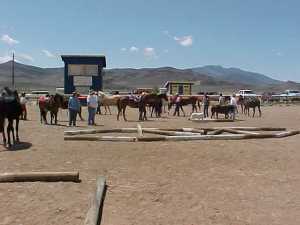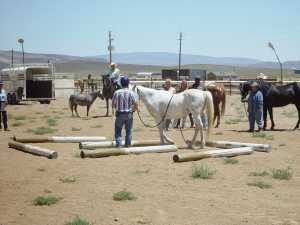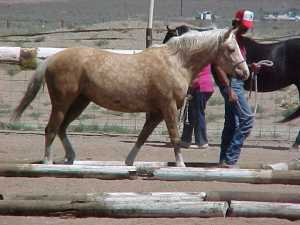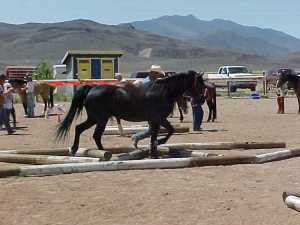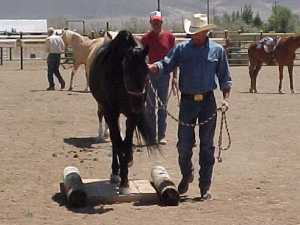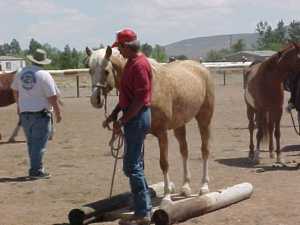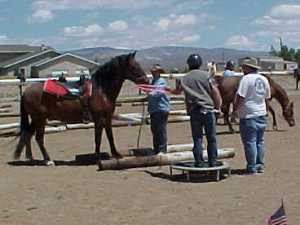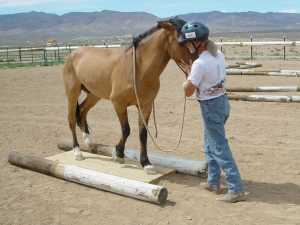Puzzles for Horses
|
The group getting assembled
| |||
May Bomb Proofing in Stagecoach
|
The Nevada LRTC members decided to get together and spend a day on the bomb proofing course.
Before working obstacles we started the session with a review of some communication basics based primarily on Frank Bell's proven "Seven Step" safety sequence. We bonded, lowered heads, touched our animals and asked them to move their feet (give laterally to slight pressure.) We had to show a few folks that they could give their horses a decent amount of lead line so their horses could find good position while being led, and could yield away from their handlers when making turns without the handler having to duck under the horse and "drag" its head with the lead rope. (We use established guidelines such as "Seven Steps" and "Seven Games" in our training. For an explanation please see Training by the Numbers.) |
|
The Labyrinth
The first obstacle was the labyrinth. The objectives of the labyrinth include simple focus and responding to light lead line aids in a confined space. The horse and handler each had to stay inside the labyrinth. It included 180 degree turns to both the left and right. The handler had to position his or her horse correctly to make the turns and the horse had to quietly stop in order to set up for each turn. Each horse had to pay attention to his handler and at the same time keep track of where his feet were in relation to the poles. |
Scout weaving the labyrinth off-lead
|
|
The Narrow Mountain trail
As each horse could handle the labyrinth with some degree of smoothness, horse and handler would proceed to the narrow mountain trail. The trail was about 70 feet long, 18 inches wide and had two 90 degree and two 45 degree turns. Step out of bounds and the handler or horse falls off the simulated cliff. The handlers started to look ahead as to where they were going rather than down at their feet and the horses picked up on that subtle change. In a short time most handlers and horses were making the entire run without the horse pushing the handler over the "cliff" or the horse stepping out of bounds. |
Eric and Cheyenne on the "Narrow Mountain Trail"
|
|
Fallen Log Lane
The next obstacle was Fallen Log Lane. The arrangements of the poles, some raised and leaning on other poles, required the handlers to focus on their own footing and at the same time give their horses enough lead so that the horses could pick their own way. It wasn't practical to strike a straight line through the clutter nor force the direction of a horse's head using the lead. Horse and handler had to focus on their destination (with the handler focused on the exit, not at his or her feet) and the handlers had to let the horses use their own instinctive abilities to pick through the poles. |
Adam and Courage traversing "Fallen Log Lane"
|
|
The Little Bridge
The Little Bridge is a simple obstacle, only 24 inches wide by eight feet long, that has a whole host of possibilities. Handlers and horses walked over the bridge end to end, sideways, stopped on the bridge, asked the horses to stand quietly on the bridge, backed their horses over the bridge, etc. A lot of time was spent getting smooth doing different things on that simple little bridge. Being small it was easy for the horses to want to simply walk around rather than over the bridge. Handlers had to focus on their position and their horses' position. Also, handlers learned that if they looked down at the bridge, their horses tended to be wary of the bridge. If the handlers looked straight ahead and their body language suggested moving across, their horses tended to walk straight ahead and over the bridge. We also added some elements such as jumping on a trampoline and shaking a rattle hoop while the horses were asked to walk over and stand on the bridge. |
Adam and Courage on the "Little Bridge"
|
Eric parking cheyenne on the bridge
|
Bouncing on the trampoline with Dusty
|
Continue to the Next Part
|

